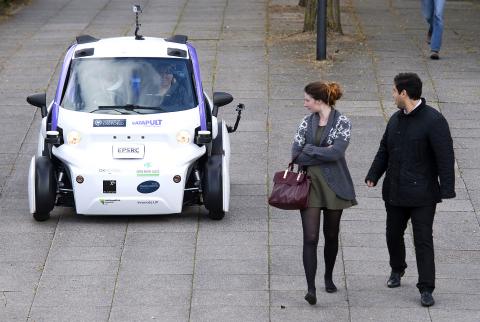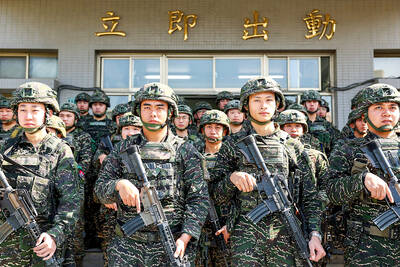In certain sunny climes, self-driving cars are multiplying. Dressed in signature spinning sensors, the vehicles putter along roads in California, Arizona and Nevada, hoovering up data that will one day make them smart enough to run without humans.
Besides perennial sunshine, those places share other common traits: wide, well-manicured roads, functional traffic enforcement, and agreeable local governments. That’s how Chandler, Arizona — a Phoenix suburb on nobody’s radar as of a few weeks ago — became the first US town to host autonomous cars on public streets without human safety drivers. Courtesy of Waymo, they’re expected to start carrying passengers within the next few months.
If you ask many Silicon Valley companies, the future of driverless cars is just a couple of years away. But halfway across the world, the outlook is a lot more skeptical.

Photo: AP
“We don’t have the luxury of California roads,” says Olga Uskova of Cognitive Technologies, a Russian software maker that specializes in autonomous vehicles. “The environment is ever-changing: the snow has covered traffic signs; it’s raining on your windshield, the sun is blocking you. Our people train using these kinds of data.”
BAD TRAFFIC
Uskova asserts that technology tested in sun-drenched utopias can’t possibly translate to a city like Moscow. Gnarly road planning, terrible weather and reckless habits make the Russian capital one of the worst cities in the world for drivers.

Photo: AFP
With roads that spread like a cobweb away from the Kremlin, disturbances like car wrecks, construction and government motorcades can wreak havoc for miles. Seat belts are scorned, and traffic laws widely ignored; speeding violations are enforced with US$4 fines, paid by phone. It’s no surprise that Russia’s rate of road fatalities is nearly double that of the US, with an average of 20 serious accidents a day just in Moscow.
Or, for that matter, that dashcam videos of Russian road fights and collisions make up such a popular subgenre on YouTube.
But most of the world’s roads look more like Russia than Mountain View, and according to Uskova, that gives Russian developers an edge in building the brains of autonomous cars.

Photo: AP
That theory was tested at a recent event in Moscow, advertised as the world’s first hackathon for driverless cars. In an austere, Soviet-era dormitory, top engineering students from far-flung schools like MIT, Cambridge and Peking University sank into beanbag chairs for a three-day coding binge.
“We’re here because it’s a chance to change the world over the next 10 to 15 years,” said Mitch Mueller, a student who traveled from the University of Wisconsin to compete. They were also competing for a cash prize, bragging rights and — most importantly — the attention of participating companies, including Uber and Nvidia, eager to recruit the next generation of AI talent.
MIMICKING THE BRAIN
The event had another purpose: to advance a credo that when it comes to autonomous cars, tougher conditions produce smarter technology. Lidar — the expensive, light-pulsing sensors relied upon by current autonomous car models — is worthless in snow and thus “a fake,” says Uskova. Instead, cars should be trained to operate using high-definition cameras, low-cost radars and powerful AI that mimics the human brain.
As the 150 engineers pored over Moscow road data, it was obvious that this vision is a long ways off. Most cars struggled to identify signs, for instance, which were hard to detect in snow or rain; and for non-Russian speakers, the task was practically impossible.
“The problem is that the signs are small, and in Russia they look very similar,” explained Sami Mian, a computer scientist at Arizona State University. “The main difference is numbers and arrows, and a city entry sign can look almost the same as a stop sign. The top team had 40 percent accuracy.”
That team, three local guys from Moscow, had tapped into a secret weapon: a trove of the popular dashcam footage, which had been harvested and stored at nearby Moscow State University. Derived from 100,000 dashcam videos, that data served as the building blocks of a basic neural network hammered out by the cigarette-puffing coders, who mentioned that they had slept a total of five hours over three days.
Russian-built autonomous systems are already in use by Kamaz, Russia’s largest truck maker, and an agricultural equipment company. Both are working with Cognitive Technologies to build autonomous machines. But adapting the technology for city use, and bringing it to the international stage, is a steep battle.
No government agency has developed regulations for autonomous cars, so road testing is constrained to designated testing zones. The only car testing zone in Moscow is a 400-meter track embellished with pedestrian crossings, road signs, markings and a section with circular traffic.
It’s a lousy facsimile of Moscow roads, or any road. But even worse is its location far outside the city center: a planned ride-along was scrapped because of bad traffic.

That US assistance was a model for Taiwan’s spectacular development success was early recognized by policymakers and analysts. In a report to the US Congress for the fiscal year 1962, former President John F. Kennedy noted Taiwan’s “rapid economic growth,” was “producing a substantial net gain in living.” Kennedy had a stake in Taiwan’s achievements and the US’ official development assistance (ODA) in general: In September 1961, his entreaty to make the 1960s a “decade of development,” and an accompanying proposal for dedicated legislation to this end, had been formalized by congressional passage of the Foreign Assistance Act. Two

President William Lai’s (賴清德) March 13 national security speech marked a turning point. He signaled that the government was finally getting serious about a whole-of-society approach to defending the nation. The presidential office summarized his speech succinctly: “President Lai introduced 17 major strategies to respond to five major national security and united front threats Taiwan now faces: China’s threat to national sovereignty, its threats from infiltration and espionage activities targeting Taiwan’s military, its threats aimed at obscuring the national identity of the people of Taiwan, its threats from united front infiltration into Taiwanese society through cross-strait exchanges, and its threats from

Despite the intense sunshine, we were hardly breaking a sweat as we cruised along the flat, dedicated bike lane, well protected from the heat by a canopy of trees. The electric assist on the bikes likely made a difference, too. Far removed from the bustle and noise of the Taichung traffic, we admired the serene rural scenery, making our way over rivers, alongside rice paddies and through pear orchards. Our route for the day covered two bike paths that connect in Fengyuan District (豐原) and are best done together. The Hou-Feng Bike Path (后豐鐵馬道) runs southward from Houli District (后里) while the

March 31 to April 6 On May 13, 1950, National Taiwan University Hospital otolaryngologist Su You-peng (蘇友鵬) was summoned to the director’s office. He thought someone had complained about him practicing the violin at night, but when he entered the room, he knew something was terribly wrong. He saw several burly men who appeared to be government secret agents, and three other resident doctors: internist Hsu Chiang (許強), dermatologist Hu Pao-chen (胡寶珍) and ophthalmologist Hu Hsin-lin (胡鑫麟). They were handcuffed, herded onto two jeeps and taken to the Secrecy Bureau (保密局) for questioning. Su was still in his doctor’s robes at